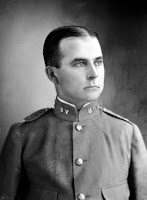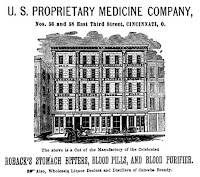 |
| Al Swearengen |
Most of the “Whiskey Men” profiled on this website were upstanding, contributing citizens of their communities. A few others had flaws but a redeeming quality or two. Ellis Alfred Swearengen, shown left, who made his name in Deadwood, South Dakota, may be a singular exception. A historian who minutely studied Swearengen’s life had this to say: "I think he was a real vicious bastard. I think he had a heart of stone.”
There is nothing in Swearengen’s background to account for the man he became. He was one of twins, the oldest of eight children born in July, 1845, in Osklaoosa, Iowa, to Kentucky-born Daniel Swearengen and his wife Keziah. Theirs was a farm family. “Al,” as he was known, and his twin brother, Lemuel, seemingly stayed at home even during early adulthood, apparently working on the farm with their father.
Our next glimpse of Swearengen is his 1876 arrival in Deadwood, South Dakota at the age of 31. With him was his wife, Nettie, 25. Showing no interest in mining as many of the inhabitants did, he apparent had already gained some experience operating an entertainment venue. Previously he had run a dance hall in Custer, South Dakota, a small but apparently successful venture. Deadwood was where the money was flowing, however, and Swearengen was drawn there.
His first enterprise in Deadwood was a make-shift timber and canvass saloon he called “The Cricket.” When that establishment proved profitable, Swearengen closed it to build a much larger saloon and dance hall called The Gem Variety Theater, shown above. The local newspaper called it as “neat and tastefully arranged as any place of its kind in the west.” The Gem provided dances, prize fights, comedians, and singers in its theatre, shown right.
The Gem also housed a well-stocked saloon, below. That is Swearengen, third from right, standing behind the substantial bar, surveying the customers. According to one observer, the theater and bar were mostly “a masquerade for its primary purpose as a brothel, which soon gained a reputation for its debasement of the women who were pressed into service there.”

 As shown here, the theatre and bar were at the front of the Gem. In the rear were rooms where the “soiled doves” plied their trade. “On its balcony, the Gem band was said to have played every night, while the girls beckoned to potential customers to come forth. Once inside, the women charged their customers 10¢ for a dance, 20¢ for a beer and $1 for a bottle of wine.” Other services were extra.
As shown here, the theatre and bar were at the front of the Gem. In the rear were rooms where the “soiled doves” plied their trade. “On its balcony, the Gem band was said to have played every night, while the girls beckoned to potential customers to come forth. Once inside, the women charged their customers 10¢ for a dance, 20¢ for a beer and $1 for a bottle of wine.” Other services were extra.
Swearingen’s wife, Nettie, left him not long after they arrived in Deadwood and later divorced him claiming spousal abuse. They had no children. Swearengen would marry two more times while in the mining town, both marriages resulting in divorces and claims of abuse by the wives. Shown below is said to be photo of the Gem’s owner, driving a buggy with one of the later wives by his side, as townsfolk looked on.
The Gem, while a popular spot with the rough and rowdy mining crowd, was notorious for gunplay. Bullets frequently could be seen flying through the saloon as drunken miners worked out their disputes. The women could also be targets and some armed themselves against harassment. Legend has it that a Gem prostitute named Tricksie shot her abuser through the front of his head after he beat her. Called to the scene a doctor probed for the bullet, amazed that the man was still alive. Thirty minutes later he wasn’t.
 |
| Seth Bullock |
At this time “law and order” in Deadwood reposed in one man, Seth Bullock. Born in Canada, Bullock and a companion had arrived in Deadwood in August 1876 looking for opportunities. Rather than scratching in the ground for gold, they went into business selling a wide range of goods, first from a wagon and then from a building they constructed at the corner of Main and Wall Streets.
From the outset, Bullock, a former Montana state senator, was convinced that Deadwood badly needed law and order if it was to thrive. Within weeks of his arrival he had become the de facto lawman of the town. When Deadwood became part of Lawrence County in April 1877, the territorial governor appointed Bullock its first sheriff. He proved to be stellar lawman, seldom resorting to a gun. As one observer noted: “During his tenure as sheriff, Bullock settled disputes over mining claims; rounded up horse thieves, road agents and stagecoach robbers; investigated murders; presided over trials; oversaw the transport and lodging of prisoners; organized militias to combat Indian attacks; and broke up countless fistfights.” It was said of him that he could outstare a mad cobra or a rogue elephant.
It was inevitable that Bullock would come into conflict with Swearengen, whose ideas and conduct went to the wild side. When the newly appointed lawman sought to regulate prostitution and gambling, he immediately ran into Al’s stout figure. After numerous disputes with the Gem’s owner, Bullock recognized that the conflict was standing in the way of taming Deadwood. By tacit agreement a line was drawn across Main Street. The more respectable sections of Deadwood on upper Main were Bullock’s territory. Lower Main, known as “The Badlands” were controlled by Swearengen.
Although the arrangement allowed the Gem to operate unimpeded, Swearengen could not control the fires that periodically burned the town. In the summer of 1879, the Gem caught fire. Damage was limited and the owner quickly repaired it and went on providing women and whiskey. Three months later, September 1879, much of Deadwood went up in flames. When the smoke cleared 300 buildings had been consumed. The Gem was among them.
Swearengen lost no time in rebuilding the Gem on the ashes of the old structure. This time he made it bigger and more ornate. When the building opened three months later, the Daily Times hailed it as Deadwood’s “finest theater building” Over the next two decades the proprietor continued to find gold without digging for it. He is said to have averaged $5,000 a night in profits, sometimes exceeding $10,000 — more than $300,000 in today’s dollar.
In 1899 a third fire consumed the Gem. This time, age 54, Swearengen called it quits, took his money and exited Deadwood forever. In addition to Bullock, now a valued community leader, he left behind a reputation that bore him considerable emnity. The Daily Times editorialized about the Gem’s demise, citing: "Harrowing tales of iniquity, shame and wretchedness; of lives wrecked and fortunes sacrificed; of vice unhindered and esteem forfeited, have been related of the place, and it is known of a verity that they have not all been groundless.” Other locals condemned the Gem as “the ever-lasting shame of Deadwood," "a vicious institution," and a "defiler of youth and a destroyer of home ties.”
Swearengen’s subsequent activities are murky. He appears to have returned to Oscaloosa and from time to time lived with relatives, including his twin brother Lemuel. Swearengen may have had some inkling his life was in danger. He left Oscaloosa only a short time before Lemuel, who ran a meat market there, was subject to a savage attack at his home. Shot five times but not robbed of $200 on his person, he survived the attack. Speculation was rife that this identical twin had been mistaken for his brother. Was someone with a grudge stalking Al Swearengen? The answer may have come two months later in November 1904.
The scourge of Deadwood, now 59 years old, was found dead near a streetcar track in Denver, Colorado. Swearengen’s obituary indicated that he was frequently in that city looking after his mining interests. He had no money in his pockets nor any indication what he might have been doing at that location. The coroner’s report called his death an accident, theorizing that he had fallen off the trolly and struck his head on the pavement, causing his death. Subsequent investigations strongly indicated that Swearwengen was murdered, having suffered a massive head wound after being struck by a heavy blunt object. He also apparently had been stripped of his cash by the killer or killers.

The story of Ellis Alfred Swearengen, however, does not end there. What went on in Deadwood has always intrigued the public. He was featured in a HBO TV series called “Deadwood” that made him the principal character. Played by the English actor Ian McShane, the fictional Swearengen is portrayed as a “vicious but charming murderer who stabs, slices and cuts his way through scores of victims” It is pure fiction. I can find no evidence of the Gem’s proprietor, nasty as he may have been, murdering anyone.
Note: There is considerable material on Swearengen to be found on the Internet,including a long footnoted article in Wikipedia. Considerable blank spots in his life story occur in the period from his childhood until he showed up in Deadwood. Similarly information about his activities after leaving the town, until his death, is largely a blank.













































